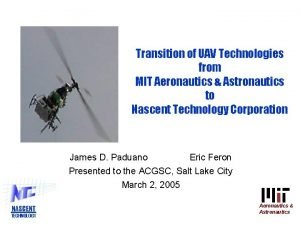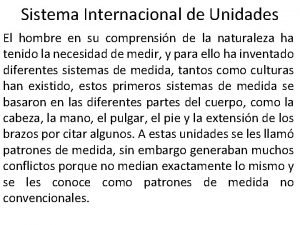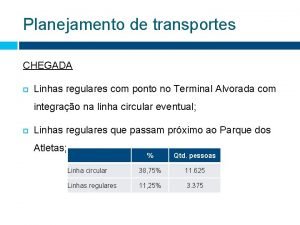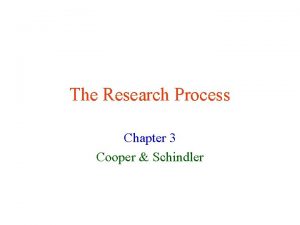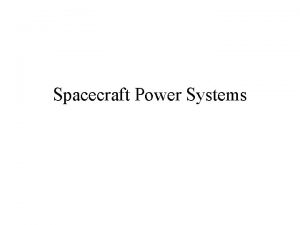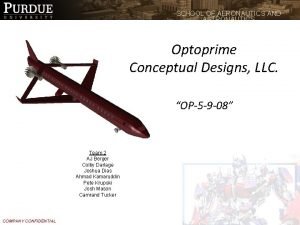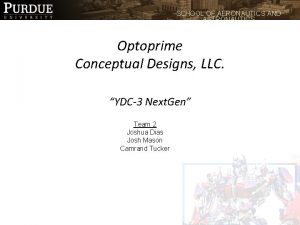ARO 309 Astronautics and Spacecraft Design Winter 2014















































- Slides: 47

ARO 309 - Astronautics and Spacecraft Design Winter 2014 Try Lam Cal. Poly Pomona Aerospace Engineering

Lecture 03: Numerical Integrations Chapter TBD

Introductions • In this lecture we will look at how dynamical system problems are solved numerically Real Life Problem In Astodynamics Problems we usually deal with Initial Value Problem (IVP) Mathematical Models (Equations) Given: Numerical Algorithm Find:

2 nd Order Runge Kutta • Given an 1 st order ODE • Applying Taylor Series expansion to 2 nd order • Since: and

2 nd Order Runge Kutta • Now we have

2 nd Order Runge Kutta • Or • The Coefficient in Butcher Tableaux form. Note:

2 nd Order Runge Kutta • Graphically slope=k 2 yn+1 (Approximate Soln) slope=k 1=f Exact Solution yo to t 1

Gernal Runge Kutta (explicit) • The explicit RK method is given by

Runge Kutta (explicit) • Note that RK must satisfy: Butcher Table

Runge Kutta (explicit) • RK 4 where

RK 4 Example • Goal: Integrate the 2 -Body Problem using RK 4 for a single step with step size = 60 sec • Equations of Motion (EOM): • State Equation (around Earth):

RK 4 Example • From the problem:

RK 4 Example

RK 4 Example • RK 4 fails for large time steps (range plot example)

Lecture 04: Two-Body Dynamics: Orbit Position as a Function of Time Chapter 3

Introductions • Chapter 2 (Lection 1 and 2) relates position as a function of θ (true anomaly) but not time • Time was only introduced when referring to orbit period • Here we attempt to find the relations between position of the S/C and time Kepler’s Equation

Time versus True Anomaly • Recall from Chapter 2 Since Then Integrating from 0 (assuming tp = 0) to t and from 0 to θ

Time versus True Anomaly

Time versus True Anomaly Simple Case: Circular Orbits (e=0) If e = 0, then therefore Since for a circular orbit we have FOR CIRCULAR ORBIT then OR

Time versus True Anomaly Elliptical Orbits (0<e<1) Then a = 1 and b = e, therefore we have b < a Me = Mean anomaly for the ellipse

Time versus True Anomaly Elliptical Orbits (0<e<1) Therefore we have From the orbit period of an ellipse we know (or can derive) that Therefore we can solve for me as function orbit period as OR where n = mean motion = 2π/Te

Time versus True Anomaly Elliptical Orbits (0<e<1) We need to fine out Me still Let’s introduce another variable E = eccentric anomaly ?

Time versus True Anomaly Elliptical Orbits (0<e<1) OR This relates E and θ, but it leaves the quadrant of the solution unknown and you get two values of E for the equation. To eliminate this ambiguity we use the following identity Therefore or

Time versus True Anomaly Elliptical Orbits (0<e<1) We need to fine out Me still E This is Kepler’s Equation

Time versus True Anomaly Elliptical Orbits (0<e<1) To find t given Δθ • Given orbital parameters, find e and h (assume θ = 0 deg) • Find E: • Find T (orbit period):

Time versus True Anomaly Elliptical Orbits (0<e<1) To find t given Δθ • Fine Me: • Find t: Question: What if you are going from a θ = θa to θ = θb? Answer: Find the time from θ = 0 to θ = θa and the time from θ = 0 to θ = θb. Then subtract the differences.

Time versus True Anomaly Elliptical Orbits (0<e<1) To find θ given Δt • Given orbital parameters, find e and h (assume θ = 0 deg • Find T (orbit period): • Find Me: • Find E using Newton’s method (or a transcendental solver)

Time versus True Anomaly Elliptical Orbits (0<e<1) To find θ given Δt • Using Newton’s Method: For Me < 180 deg – Initialize E = Eo: – Find f(E): – Find f’(E): – If abs( f(E) / f’(E) ) > TOL, then repeat with – Else Econverged = En For Me > 180 deg

Time versus True Anomaly Elliptical Orbits (0<e<1) To find θ given Δt • After finding the converged E, then find θ

Time versus True Anomaly Parabolic Orbits (e = 1) Then a = 1 and b = e, therefore we have b = a MP = Parabolic Mean Anomaly

Time versus True Anomaly Parabolic Orbits (e = 1) Thus given t or Δt we can find MP To fine θ we can find the root of the below equation Which has one real root STEPS: Find h Find MP Find θ

Time versus True Anomaly Hyperbolic Orbits (e > 1) Then a = 1 and b = e, therefore we have b > a

Time versus True Anomaly Hyperbolic Orbits (e > 1) Where the Hyperbolic mean anomaly is Thus we have Similar with Ellipse we will intro a new variable, F, the hyperbolic eccentric anomaly to help solve for the Mean Hyperbolic anomaly, Mh.

Time versus True Anomaly Hyperbolic Orbits (e > 1) Hyperbolic eccentric anomaly for the Hyperbola Since:

Time versus True Anomaly Hyperbolic Orbits (e > 1) We now have Solving for F and since Using the following trig identities for sine and cosine we now have

Time versus True Anomaly Hyperbolic Orbits (e > 1) We now have Therefore we now have: This is Kepler’s Equation for Hyperbola Similar to Elliptical orbits we can solve for F as a function of θ, which is found to be. Thus given θ we can find F, and Mh, and finally t.

Time versus True Anomaly Hyperbolic Orbits (e > 1) If time, t, was given and θ is to be found then we have to solve for Kepler’s equation for hyperbola iteratively using Newton’s method STEPS TO FIND θ (given t) • Set initial F 0 = Mh where • Find f and f’ • If abs( f / f’ ) > TOL, repeat steps with updated F • Else, Fconverged = Fi. Now find θ

Universal Variables • What happens if you don’t know what type of orbit you are in? Why use 3 set of equations? • Kepler’s equation can be written in terms of a universal variable or universal anomaly, Χ, and Kepler’s equation becomes the universal Kepler’s equation. Where If α < 0, then orbit is hyperbolic If α = 0, then orbit is parabolic If α > 0, then orbit is elliptical

Universal Variables • Stumpff functions or for z = αΧ 2 ,

Universal Variables • To use Newton’s method we need to define the following function and it’s derivative • Iterate with the following algorithm with

Universal Variables • Relation ship between X and the orbits For t 0 = 0 at periapsis

Universal Variables • Example 3. 6 (Textbook: Curtis’s) Find h and e Since , then

Universal Variables • Example 3. 6 (Textbook: Curtis’s) Therefore So X 0 is the initial X to use for the Newton’s method to find the converged X

Universal Variables • Example 3. 6 (Textbook: Curtis’s)

Universal Variables • Example 3. 6 (Textbook: Curtis’s) Thus we accept the X value of X = 128. 5 where

Lagrange Coefficients II • Recall Lagrange Coefficients in terms of f and g coefficients • From the universal anomaly X we can find the f and g coefficients

Lagrange Coefficients II Where and • Steps finding state at a future Δθ using Lagrange Coefficients 1. 2. 3. 4. 5. 6. 7. Find r 0 and v 0 from the given position and velocity vector Find vr 0 and α Find X Find f and g Find r, where r = f r 0 + g v 0 Find fdot and gdot Find v
 Spacecraft requirements management
Spacecraft requirements management Mit aeronautics and astronautics
Mit aeronautics and astronautics Pioneer astronautics internship
Pioneer astronautics internship Pico femto atto zepto yocto
Pico femto atto zepto yocto Winter kommt winter kommt flocken fallen nieder
Winter kommt winter kommt flocken fallen nieder Winter kommt winter kommt flocken fallen nieder lied
Winter kommt winter kommt flocken fallen nieder lied Was ist deine lieblingsjahreszeit
Was ist deine lieblingsjahreszeit Ics-309
Ics-309 Buku daftar pemeriksaan mengejut ap 309
Buku daftar pemeriksaan mengejut ap 309 Ssis 309
Ssis 309 309 article
309 article Es 9 pag 309
Es 9 pag 309 309 90
309 90 Ereferrals.bcbsm.com
Ereferrals.bcbsm.com Maksud dana apungan tunai runcit
Maksud dana apungan tunai runcit Se01 alvorada
Se01 alvorada Panjar perkhidmatan
Panjar perkhidmatan Ncg 309
Ncg 309 309 series
309 series Indicativo 309
Indicativo 309 Te aro neweak lako di papua
Te aro neweak lako di papua Te aro neweak lako di papua
Te aro neweak lako di papua Ara are ari aro aru
Ara are ari aro aru Aros seguridad y salud en el trabajo
Aros seguridad y salud en el trabajo Simo aro
Simo aro Aros klinik
Aros klinik Aro diaphragm pump troubleshooting
Aro diaphragm pump troubleshooting Aro baa
Aro baa How is the value of a safeguard to a company calculated?
How is the value of a safeguard to a company calculated? Citc ksa
Citc ksa Lrre
Lrre Te aro neweak lako adalah
Te aro neweak lako adalah Aro lauzelle
Aro lauzelle Input and output form design
Input and output form design Principles of social services and wellbeing act
Principles of social services and wellbeing act Social services and wellbeing (wales) act 2014 easy read
Social services and wellbeing (wales) act 2014 easy read Veterinary nurse conduct and discipline rules 2014
Veterinary nurse conduct and discipline rules 2014 Nora schindler
Nora schindler Punjab free and compulsory education act 2014
Punjab free and compulsory education act 2014 Npsb vs beftn
Npsb vs beftn Cast of spring, summer, fall, winter... and spring
Cast of spring, summer, fall, winter... and spring Weather spring summer autumn winter
Weather spring summer autumn winter Months of spring
Months of spring Pie chart showing the summer and winter solstice
Pie chart showing the summer and winter solstice Poems with metaphor and simile
Poems with metaphor and simile Summer and winter uniform
Summer and winter uniform Diamante poem winter and summer
Diamante poem winter and summer Language
Language

